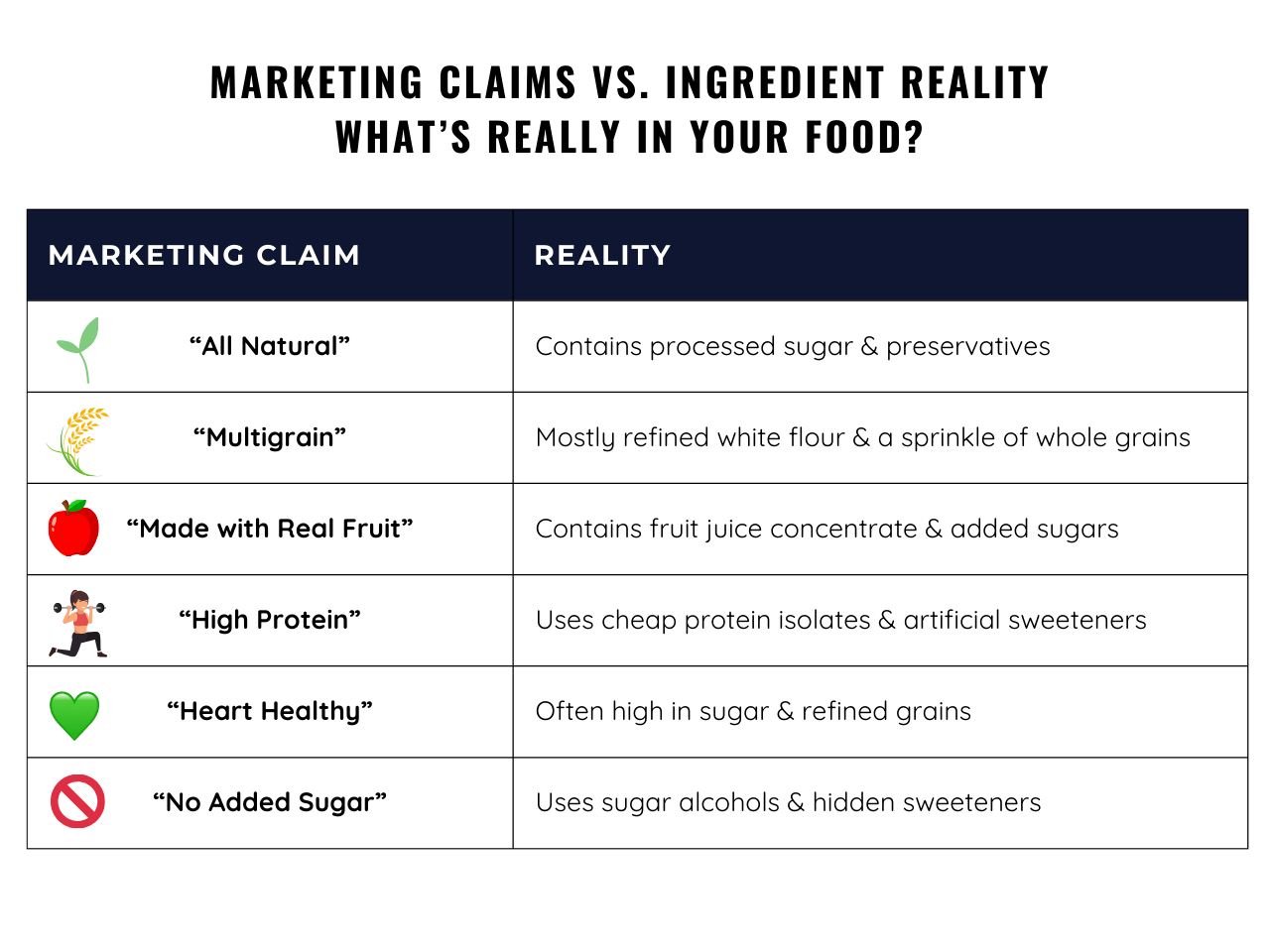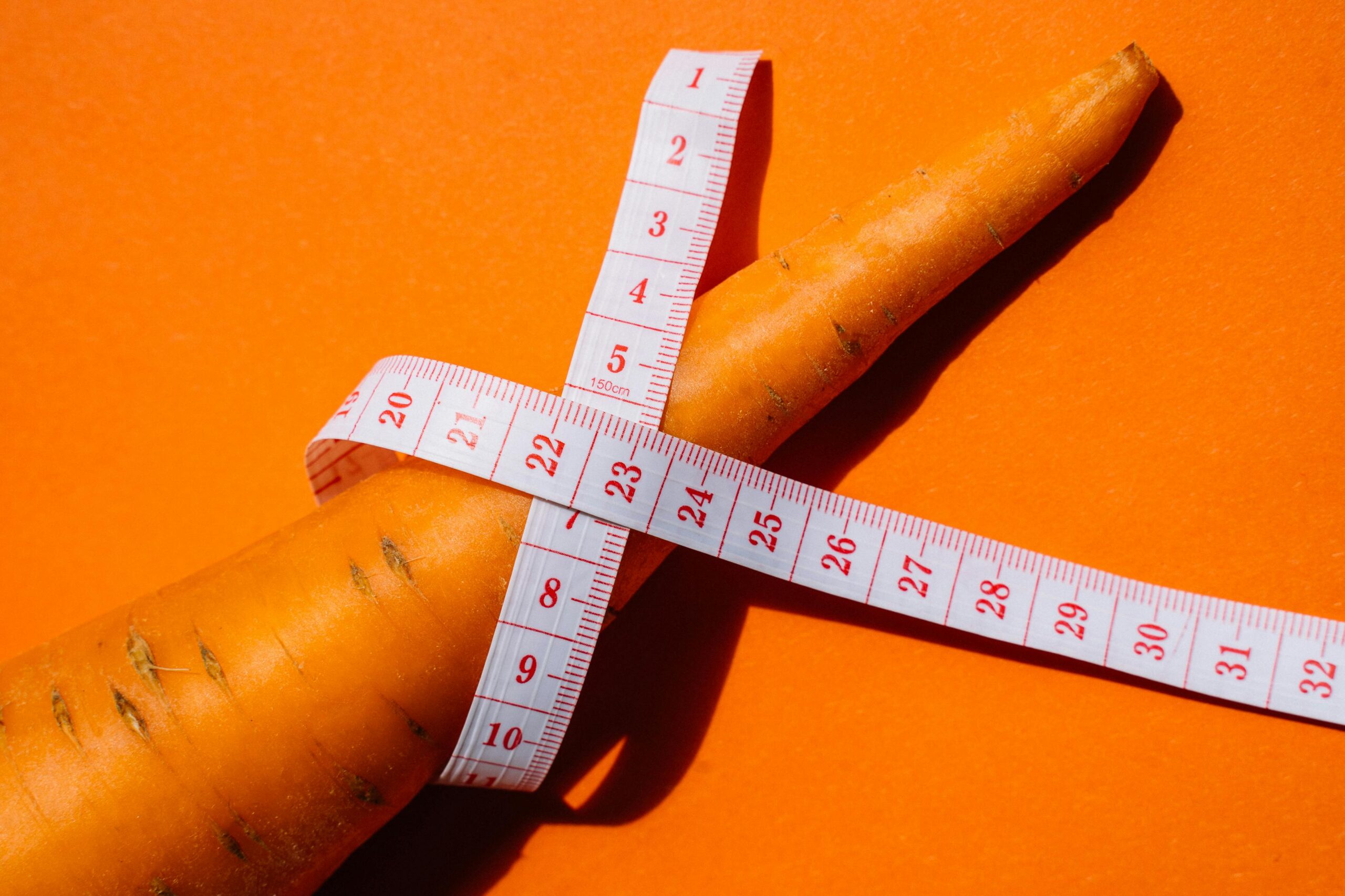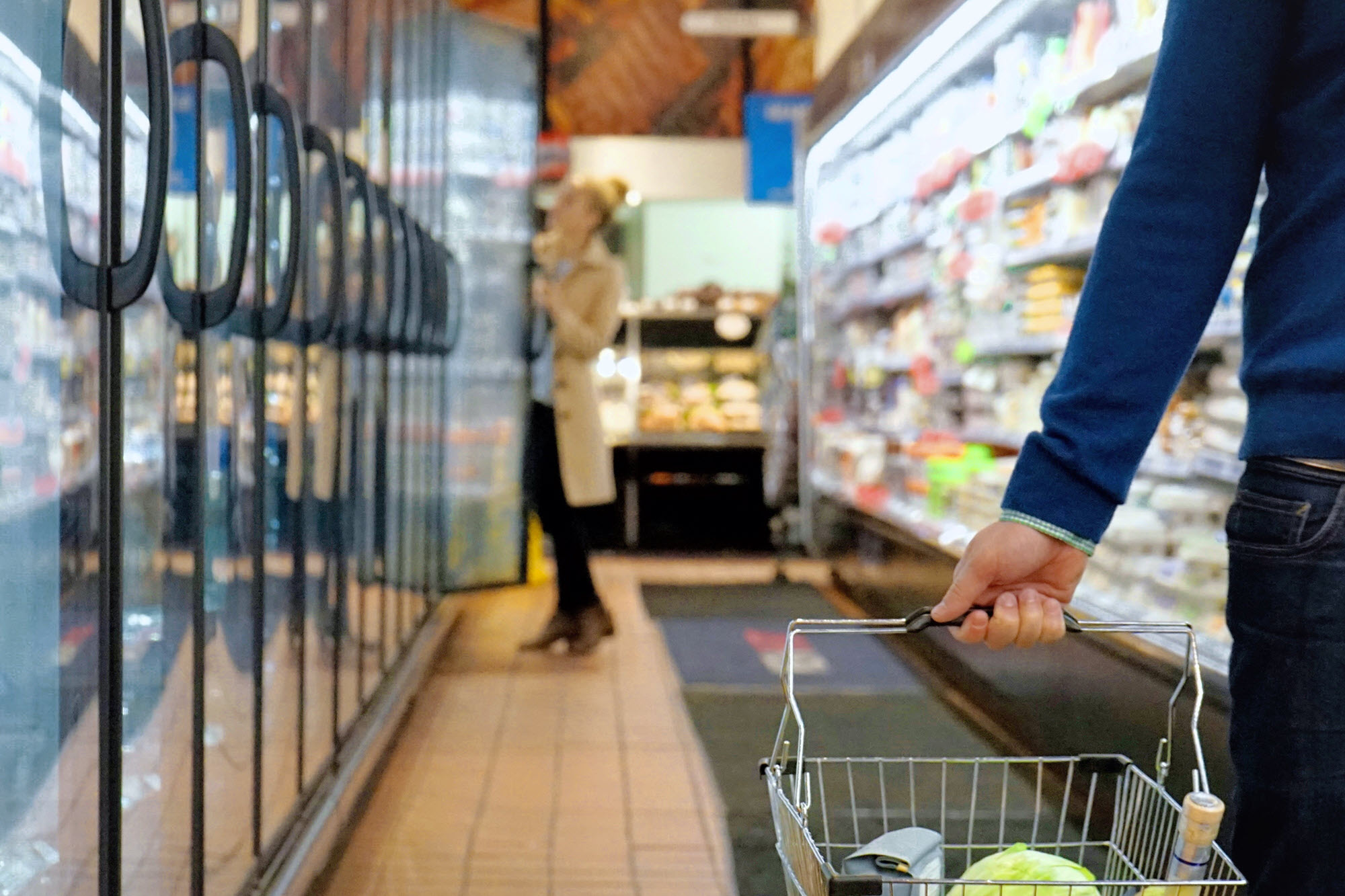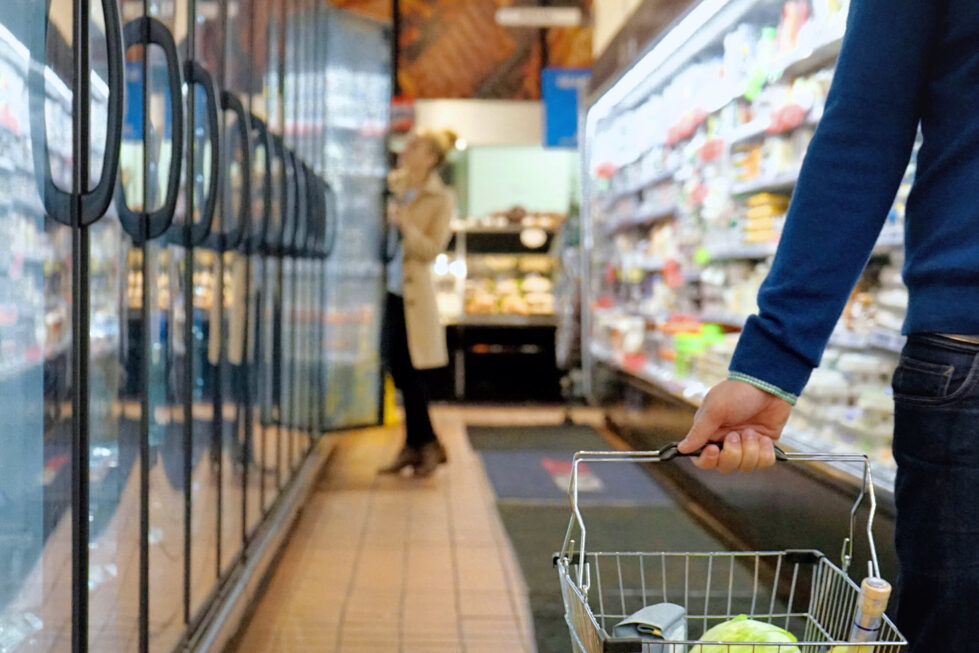Think that ‘natural,’ ‘multigrain,’ or ‘no added sugar’ label means a product is healthy? Think again. These labels are carefully crafted to mislead you—here’s how.
Food label lies are everywhere. Instead of being transparent, food companies use strategic wording, misleading serving sizes, and hidden ingredients to make ultra-processed foods appear healthier than they really are—all in the name of profit.
The global health and wellness food market is valued at $841 billion and is expected to surpass $1 trillion by 2028. Yet, instead of improving food quality, brands prioritize perception over reality, using deceptive labeling to influence consumer choices.
But here’s the good news: Once you understand how food label lies work, you’ll never fall for deceptive packaging again.
How Food Label Lies Trick You into Thinking Products Are Healthy
Food labels are supposed to provide honest nutritional information, yet they are carefully designed marketing tools meant to shape consumer perception rather than reflect reality.
The ‘Health Halo’ Effect
A product labeled “natural” or “low-fat” instantly appears healthier—even if its ingredients are nearly identical to competing brands. This cognitive bias, known as the Health Halo Effect, makes consumers trust packaging claims more than they should.
A study in the Journal of Consumer Research found that consumers rated “low-fat” foods as healthier—even when they contained just as much sugar and additives as their regular counterparts.
Profits Over Transparency
Food companies exploit regulatory loopholes to increase sales while making minimal changes to their products. Terms like:
- “Whole grain” can legally refer to a product with mostly refined flour.
- “Sugar-free” may still contain high-glycemic sweeteners that spike blood sugar.
- “Natural” has no strict definition—yet it’s one of the most profitable claims in the food industry.
A whole grain or organic label can increase sales by 30%, even when the product isn’t significantly healthier.
How to Outsmart Food Label Lies & Read Packaging Like a Pro
Before you buy, ask yourself these three questions:
1. Who Benefits from This Claim?
- Is the label designed to inform you—or manipulate you?
- Unverified claims like “All Natural” or “Heart Healthy” are marketing tactics, not guarantees of quality.
2. What’s the First Ingredient?
- The first ingredient on the list makes up the largest portion of the product.
- If it’s sugar, refined flour, or a processed additive, the product isn’t as healthy as it claims.
- Common disguised sugars to watch for:
-
- Evaporated Cane Juice
- Organic Brown Rice Syrup
- Fruit Juice Concentrate
3. Are There Additives & Preservatives?
- Long chemical names = ultra-processed food.
- Common red flags:
- MSG & Hidden Glutamates → Yeast extract, hydrolyzed protein, autolyzed yeast.
- Artificial Sweeteners → Aspartame, sucralose, acesulfame potassium.
- Preservatives → Sodium benzoate, BHT, calcium disodium EDTA.
Pro Tip: If a product has more than 5-7 ingredients and includes multiple preservatives, it’s ultra-processed.
Marketing Claims vs. Ingredient Reality
Food companies rely on food label lies and carefully crafted wording to make processed foods appear healthier than they are. Terms like "natural," "multigrain," and "high protein" often disguise low-quality ingredients and ultra-processed formulas.
The table below breaks down some of the most misleading food marketing claims—and what they mean:

Takeaway: Flip the package. The real truth is always in the ingredients list—not the front-label claims.
Five of the Biggest Food Label Lies—and How to Spot Them
Deceptive labels don’t just use misleading words—they are part of a larger marketing strategy that keeps consumers uninformed about what’s really inside their food. Below are the five most common ways brands distort food labels—and how you can see through their tactics.
1. The Serving Size Scam—Why You’re Eating More Than You Think
Food companies shrink serving sizes to make calorie, sugar, and fat counts appear lower than they are.
How It Works
Despite updated FDA regulations, brands still manipulate serving sizes.- A 20-ounce soda was once labeled as 2.5 servings to minimize the sugar count—until the FDA required it to be counted as one. However, the same trick still applies to multi-serving snacks and frozen meals.
- Similarly, ice cream servings were adjusted from ½ cup to ⅔ cup, but many brands still list unrealistically small portions to downplay calorie counts.
How to Spot It
- Check the "servings per container"—not just the per-serving stats.
- Do the math: If the portion size seems too small to be realistic, assume you're eating more.
- Compare with real-world portions: A granola bar, snack bag, or bottled drink is often meant to be eaten in one sitting—regardless of what the label claims.
2. ‘Natural’ on a Label—Is It Actually Healthy?
The "natural" label is one of the biggest examples of the Health Halo Effect in action. Since the FDA has no strict definition, companies legally use it on ultra-processed products that still contain:
- Processed sugars that spike blood sugar
- Modified fats that affect metabolism
- Artificial “natural flavors” designed to mimic real ingredients
Dr. Marion Nestle, food policy expert, explains:
"Companies know that words like ‘organic’ and ‘natural’ influence purchasing decisions—even when the product contains the same additives and sugars as competitors."
How to Spot the Deception
- Ignore front-label claims—flip the package over and read the ingredients.
- Look for hidden additives, refined sugars, or preservatives—if they’re present, the product isn’t as “natural” as it seems.
And this deception isn’t accidental—it’s by design. Michael Pollan, best-selling author of The Omnivore’s Dilemma, has spent decades exposing how the food industry uses labels as marketing weapons instead of transparency tools. He puts it bluntly:
"The food industry has done an excellent job of convincing us that highly processed food is ‘natural’—even when it’s anything but."
3. Sugar-Free Lies—The Hidden Sugars in Your Food
Think “sugar-free” means it won’t affect blood sugar? Not so fast. Many products labeled as sugar-free still cause blood sugar spikes—sometimes even more than regular sugar.
One major culprit? Maltodextrin. Despite being marketed as a sugar alternative, this ultra-processed carbohydrate has a higher glycemic index than table sugar, meaning it can raise blood sugar levels even faster. Food companies use it to add bulk or texture in everything from “low-carb” protein bars to diet sodas—all while slapping a “sugar-free” label on the front.
In 2018, Coca-Cola was suedfor misleading ‘no added sugar’ claims, despite using fruit juice concentrates that spiked blood sugar levels.
Hidden Sugars to Watch For
- Maltodextrin → Spikes blood sugar faster than table sugar
- Dextrose, Fructose, HFCS, Agave Nectar, Brown Rice Syrup→ Different names, same effect
How to Spot It
- Don’t trust front-label claims—flip the package and check the ingredient list.
- If a product still tastes sweet but says “sugar-free,” look for hidden sweeteners like maltodextrin or syrups.
- Check total carbohydrates, not just “sugar”—many hidden sweeteners don’t count as sugar on nutrition labels but still raise blood glucose levels.
4. Multigrain vs. Whole Grain—What’s the Difference?
Whole grains are packed with fiber and nutrients—but they’re bad for food companies’ bottom lines. Refined flour is cheaper, lasts longer, and keeps you coming back for more. That’s why brands slap “multigrain” on packaging and hope you don’t check the ingredients.
How to Spot It:
- Multigrain ≠ Whole Grain – It just means a mix of grains, many of which are refined and stripped of fiber.
- Unless a label says “100% whole grain,” the product likely contains mostly white flour with little nutritional value.
5. The Truth About MSG and Hidden Additives
MSG (monosodium glutamate) is a flavor enhancer found in many processed foods. While the FDA considers it safe, some people report sensitivities, including headaches and bloating.
Where MSG Hides
Even products labeled "No MSG Added" can still contain free glutamate under different names, including:
- Yeast extract
- Hydrolyzed protein
- Autolyzed yeast
How to Spot Hidden Additives
- Look for artificial colors like Red 40 or Yellow 5—these are often found in brightly colored processed foods.
- If a product has a long list of unpronounceable ingredients, it’s likely packed with chemicals.
Breaking News: Red No. 3 Ban
In January 2025, the FDA officially banned Red No. 3 due to its link to cancer in animal studies.
Cutting Through the Confusion: Making Smarter Food Choices
Rather than informing you, food labels are designed to sell. With vague terms like 'natural' and 'multigrain,' hidden sugars, and deceptive serving sizes, the food industry capitalizes on consumer misunderstanding.
As Michael Pollan famously puts it:
"Don’t eat anything your great-grandmother wouldn’t recognize as food."
It’s a simple but powerful rule—because real food doesn’t need health claims. It doesn’t need a flashy label. It just is.
At Trustpoint Health, we believe knowledge is power. Our functional medicine experts break through industry deception with science-backed insights, helping you make informed, confident choices about your health.
Tired of food industry deception? Get the truth about nutrition, ingredient transparency, and ultra-processed foods from our expert-backed Learning Center.

How Functional Medicine Treats Stress: A Step-by-Step Guide

How Functional Medicine Supplements Can Help with Weight Loss

Vitamin D Benefits: 7 Ways to Boost Energy, Immunity & Health


